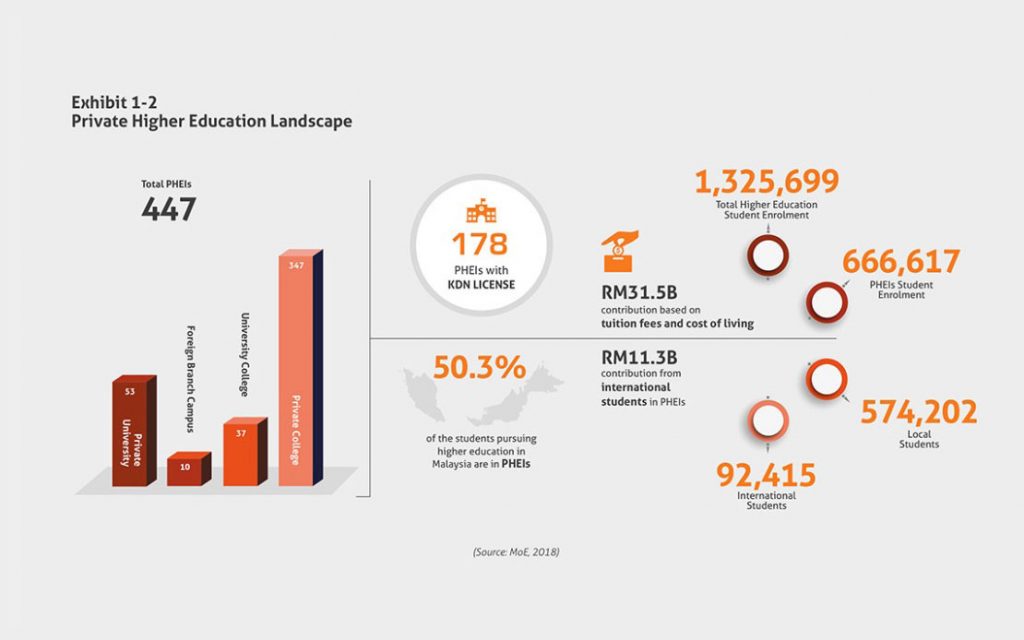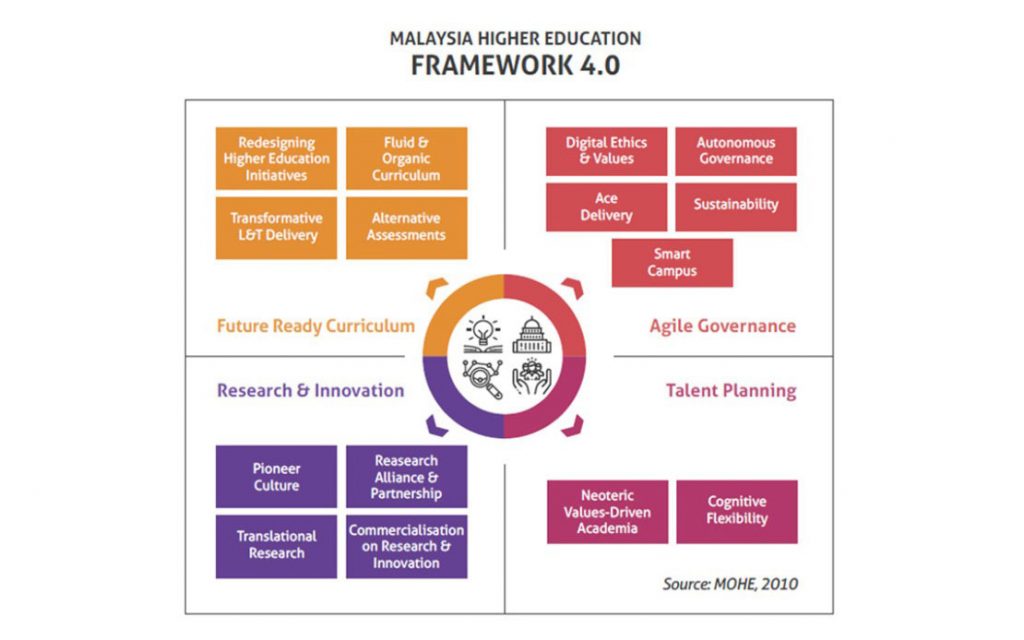Evolution of e-Learning in the Malaysian Higher Education Institutions
08 Feb 2021
By : Malaysian Investment Development Authority
Malaysia’s higher education system has matured considerably over the years and is undergoing a comprehensive transformation. The curriculum and teaching methods are being revamped with new critical elements such as experiential learning, organic and flexible curriculum, and lifelong learning mind-set to develop future-ready graduates. Graduates’ skillsets are also further enriched to embrace opportunities within the gig economy.
Following the Ministry of Higher Education (MOHE)’s report ‘The Way Forward for Private Higher Education Institutions: Education as an Industry (2020-2025)’; as of 30 September 2019, there were a total of 1,325,699 students pursuing their tertiary education in higher education institutions (HEIs) in Malaysia. This consists of 666,617 students (51.0 per cent) in over 400 private HEIs (PHEIs) and 659,082 students (49.0 per cent) in 20 public universities and branch campuses. As for the international students’ enrollment, over 70 per cent (92,415 students) are in PHEIs, and 30 per cent (39,099 students) are registered in public universities. Malaysia aims to continue positioning itself as an international education hub, targeting 250,000 international students by 2025.

Source: Way Forward for PHEI’s as an Industry (2020-2025), MOHE
The higher education sector is progressing fast towards the Industry 4.0 (IR4.0) and for the institutions to attain and maintain its institutional sustainability; it is of paramount importance that they must continue to improve their teaching and learning delivery system to produce quality graduates who are ready for the workplace, in line with the Malaysian Higher Education framework 4.0;

The unprecedented outbreak of the COVID-19 pandemic has contributed to the rise of e-learning. As Professor Dr. Abdul Karim Alias, Director of Centre for Development of Academic Excellence (CDAE) from the Universiti Sains Malaysia (USM) emphasised, “The online learning and online education are no longer an option – it’s a must.”
E-learning is a technology trend which provides the opportunity for lifelong learning and requires digital literacy readiness. The Malaysia Education Blueprint 2015-2025 (Higher Education) highlighted the importance and priorities of digital literacy, critical thinking and problem solving as the 21st-century learning skills that will help students thrive in IR4.0. Connectivity through multimedia mobile devices, experiential learning through Virtual Reality (VR), Augmented Reality (AR), Mixed Reality (MR), Artificial Intelligence (AI) and the Internet of Things (IoTs) has created a new learning ecosystem in the higher education. In order to effectively harness these new technologies and learning paradigms, higher education needs to develop and put in place an infrastructure of the right education, networks of people and quality assurances.
In response to the new normal resulting from the pandemic, Malaysia’s higher learning institutions have jump-started their initiatives in adopting the e-learning approaches, denoting the Open and Distance Learning (ODL) practices. ODL has been an emerging trend to access quality education, create lifelong learning opportunities, flexible modes of learning methods and conducive learning environment for young school leavers, university communities and working population. Students participate in online lectures, tutorials and self-directed online learning. In contrast to physical tests, online tests and assignments may even allow students to instantly review the marks and obtain feedback to improve their next sittings.
A total of nine education institutions have been operating primarily as ODL Universities. Open University Malaysia (OUM) is one of the earliest e-learning institutions in operation since 2001, located in Petaling Jaya, Kuala Lumpur. From its first intake of 753 students, OUM has produced over 85,000 graduates. Other ODL Universities established over the years include Wawasan Open University (WOU), GlobalNxt University, Asia E-University, Veritas University College, UNITAR International University, Universiti Tun Abdul Razak (UNIRAZAK), Al-Madinah International University (MEDIU) and Genovasi University College. However, the delivery of programmes in ODL mode is not limited to the above. Many other “conventional-mode” private Universities also selectively offer some ODL mode programmes to complement full-fledged physical programmes.
In addition, premier public universities in Malaysia such as Universiti Sains Malaysia (USM), Universiti Utara Malaysia (UUM), Universiti Malaya (UM), Universiti Teknologi Malaysia (UTM) and Universiti Teknologi MARA (UiTM), have also been offering similar e-learning programmes through Massive Open Online Courses (MOOCs) such as USM that uses this teaching module approach for the past 18 years.
To ensure the effectiveness of the e-learning system among students and teachers, adequate hardware and high accessibility to internet connection throughout the country are very much required. MOE’s online learning readiness survey in March 2020 indicated that access to gadgets at home as one of the main factors to gauge in increasing digital literacy among students.
In addressing such challenges, the Malaysian Communications and Multimedia Commission (MCMC) launched the National Fiberisation and Connectivity Plan (NFCP) 2019-2023 on 19 September 2019. This initiative targets to provide average internet speed of 30Mbps in 98 per cent of populated areas by 2023 as well as fibre network passes to 70 per cent of schools, hospitals, libraries, police stations and post offices by 2022. The Government will also embark on a 5G network roll out in various states in fibre optics infrastructure and digital application ecosystem development. It will potentially broaden deployment and greater accessibility of e-learning through connected devices in homes, offices and educational institutions all over Malaysia.
The implementation of e-learning by higher educational institutions offers vast business opportunities to technology providers as well. Global support by Scribd, Audible Stories, Cambridge University Press and JSTOR to provide free services of e-books, textbooks, audiobooks and research journals further complements the global e-learning momentum, especially during these uncertain times.
To produce future ready graduates, PHEIs including Technical and vocational education and training (TVETs) should introduce emerging technology competencies in the programmes such as enabling technologies for Industry Revolution 4.0 as stipulated in the National Policy on Industry 4.0 (Industry4WRD). The curriculum must be built and revised to be both industry and community relevant to embed data analytics and nine pillars of IR4.0 technological advances such as autonomous robots, simulation, system Integration, IoT, cybersecurity, cloud, augmented reality (AR), and additive manufacturing. There should be greater collaboration between higher education and industry partners to enhance curriculum and ensure its relevance to the current market demands. These measures are part of acknowledging that education must change to meet the needs of a new digital era and prepare future talents to be part of the IR4.0 workforce.
It is pivotal for higher education institutions to invest in the education technology infrastructure and network to harness new learning trends effectively. To support this initiative, the Malaysian Investment Development Authority (MIDA) being the country’s principal investment promotion agency, continuously encourages local and foreign investors to tap into investment opportunities and incentives available in the education sector. MIDA welcomes companies to venture in new growth areas of high value-added, knowledge-based technology in creating a conducive and engaging lifelong learning environment in Malaysia.
In this regard, several PHEIs have taken the lead in embracing Industry 4.0 and infusing disruptive technologies into their curriculum, management and delivery of their services. A primary example is the Asia Pacific University of Technology and Innovation (APU), among the pioneer University awarded the Premier Digital Technology Institution (PDTI) status by Malaysia Digital Economy Corporation (MDEC). APU has progressed into its Digital Transformation journey, involving the movement of its applications and resources to the Cloud as well as the unification of all its applications and online services into a single, consistent interface accessible across all major platforms, in enhancing the availability, reliability and performance of its core services. APU has invested heavily in establishing a Cyber Range and Security Operations Centre that is considered among the most advanced in the region, and created state of the art XR (eXtended Reality) facilities to drive the development in this area. APU also designed and launched Malaysia’s first ever postgraduate programme in Data Analytics in 2015.
With the advent of Internet of Thing (IoT) and smart technologies evolving rapidly, many PHEIs and TVETs are recognising their significance in optimising student and faculty success. The smart campus approach is presented as a composition of ambient learning spaces, where physical learning resources is augmenting with digital and social services. Today, connected devices, cameras, sensors, and machines embedded with smart technology increasingly used in campuses throughout the nation. Some examples of these technologies applied to smart campuses are cloud computing and centralisation of data, smart classroom, smart security (access control systems, biometric sensors or Radio-frequency identification (RFID) readers), smart management (analytics dashboard) and smart facilities (smart lighting, smart surveillance).
PHEIs including Technical and Vocational Education and Training Institution (TVET) may apply for the Domestic Investment Strategic Fund (DISF) and the Smart Automation Grant under PENJANA to support the adoption of technology and innovation in the teaching and courses offered by the Institutions. The funds’ objectives are to upgrade the institution’s technological capabilities to be more competitive, move-up the value chain, and enable to be active in the global ecosystem. The funds will cater to expenditures incurred in training of Malaysians, R&D activities, automation, modernisation and upgrading of facilities, obtaining international standards/certification and licensing or purchasing new/high technology.
To further empower TVET institutions towards the new norm of education, a total of RM6 billion, including RM30 million for the Skills Development Fund Corporation (PTPK) and RM60 million in providing RM1,000 monthly allowance for National Dual Training System Plus has been approved under Budget 2021.
MIDA also initiated a structured MIDA-Academia-Industry collaboration framework to address investors’ human capital needs. Among others, the collaboration between First Solar Malaysia with Universiti Malaysia Perlis (UniMAP), Biocon Malaysia with SEGi College and Samsung Malaysia with University Teknikal Melaka (UTeM) which allows supplies of graduates for internship and access to digital facilities to nurture the growth and potential of students and lecturers.
Collaboration among academia, industry, government and community to intensify the commercialisation of ideas was also initiated by Collaborative Research in Engineering, Science and Technology Centre (CREST) since 2012 and Public-Private Research Network (PPRN) since 2014 in bridging the industry and academia expertise. CREST has collaborated with MIDA to enhance the R&D ecosystem, particularly in the Electrical and Electronics (E&E) industry to support six (6) key technology clusters, including the IoT, Embedded Systems and Industry 4.0. The support continues as the Government has allocated RM9 million to CREST to undertake R&D activities and related programmes under Budget 2021.
To further drive the industry-academia collaboration, the Government is offering tax incentive for the commercialisation of resource and non-resource based R&D findings by the public and private higher learning institutions. MIDA looks forward to heightened R&D activities by universities and colleges in Malaysia as the institutions innovate dynamic teaching and research modes in producing skilled graduates and dedicated researchers for future industries and businesses.
Source: Bernama


